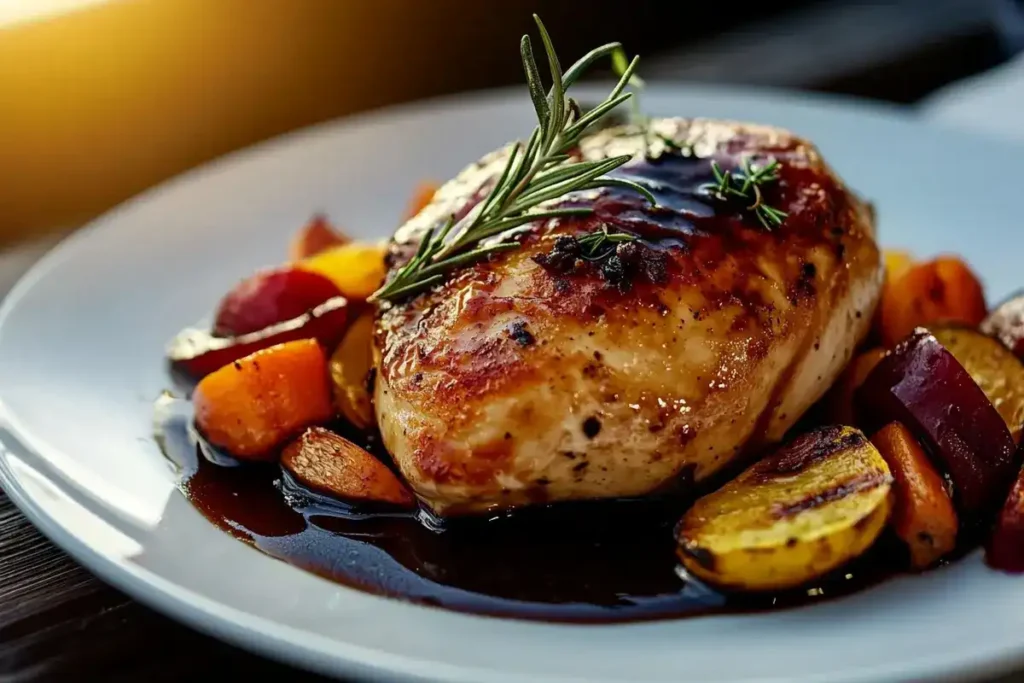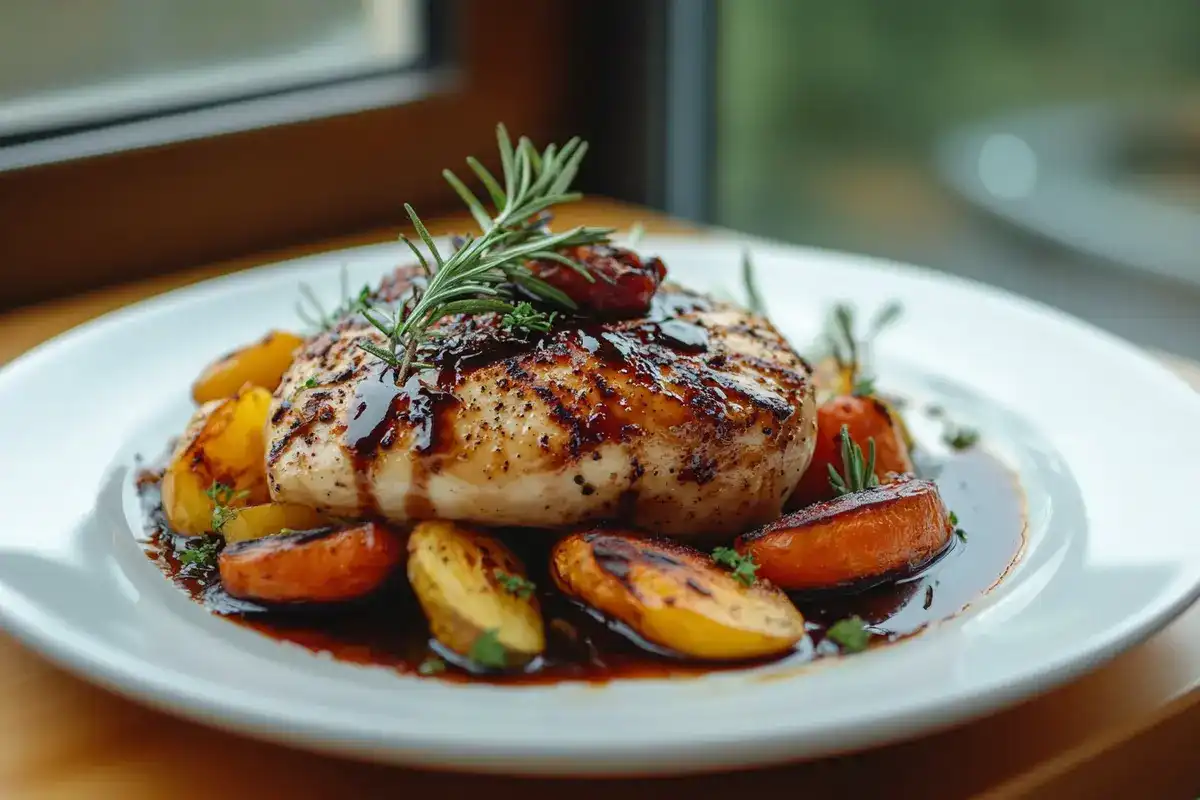Balsamic chicken is a delightful dish that pairs tender chicken with the rich, tangy flavor of balsamic vinegar. Whether you’re a seasoned chef or just starting out in the kitchen, this recipe is perfect for crafting a flavorful, versatile meal. In this article, we’ll explore everything from the essential ingredients to cooking methods, serving suggestions, and even answers to common questions about this dish. Let’s dive in!
Table of contents
- Introduction to Balsamic Chicken
- Ingredients for the Perfect Balsamic Chicken
- Step-by-Step Preparation of Balsamic Chicken
- Flavor Variations and Add-Ons
- Health Benefits of Balsamic Chicken
- Serving Suggestions and Pairings
- Troubleshooting and Common Mistakes
- Frequently Asked Questions
- Conclusion and Final Thoughts
Introduction to Balsamic Chicken
What is Balsamic Chicken?
Balsamic chicken is a simple yet elegant dish that highlights the unique, tangy sweetness of balsamic vinegar. This ingredient, often paired with olive oil and aromatic herbs, transforms ordinary chicken into a culinary masterpiece. It’s a dish that’s equally at home on a busy weeknight or as the centerpiece of a dinner party.
Origins and Popularity of Balsamic Chicken
The origins of balsamic chicken can be traced back to Mediterranean cuisine, where balsamic vinegar has long been a staple. Over the years, this dish has gained popularity worldwide, thanks to its bold flavors and adaptability. It’s celebrated for its balance of savory and sweet, making it a go-to option for food lovers.
Why Choose Balsamic Chicken?
Why should this recipe be on your must-try list? The answer is simple: it’s easy, delicious, and healthy. The combination of balsamic vinegar and lean chicken creates a dish that’s packed with flavor yet light on calories. Plus, it’s highly versatile—you can bake, grill, or sauté it, and pair it with a variety of sides to suit your taste.
Ingredients for the Perfect Balsamic Chicken
Key Ingredients Explained
Creating a mouthwatering Balsamic Chicken Recipe begins with quality ingredients. At the heart of the dish is balsamic vinegar, known for its deep, tangy sweetness. Pair this with extra virgin olive oil, garlic, and honey for a balanced marinade. Fresh or dried herbs like rosemary, thyme, or basil elevate the dish with aromatic layers, while salt and pepper bring out the chicken’s natural flavors.
Choosing the Right Chicken for Your Recipe
The choice of chicken can make or break the dish. Boneless, skinless chicken breasts or thighs are preferred for their tenderness and ability to absorb the rich flavors of the marinade. When possible, opt for organic or free-range chicken for better texture and taste.
Understanding Balsamic Vinegar and Its Role in Cooking
Balsamic vinegar is more than just a marinade—it’s a flavor enhancer that caramelizes beautifully during cooking, giving the chicken a glossy, slightly sweet finish. Aged balsamic or balsamic glaze can be used for an added touch of luxury. This key ingredient helps balance the savory and sweet elements of the recipe.
For more tips on using marinades effectively, check out Easy Crispy Baked Chicken for complementary ideas.
Step-by-Step Preparation of Balsamic Chicken
How to Make a Balsamic Marinade
The marinade is the soul of any Balsamic Chicken Recipe. Combine balsamic vinegar, olive oil, minced garlic, honey, Dijon mustard, and your choice of herbs in a bowl. Whisk until emulsified, ensuring all ingredients are evenly blended. A dash of red pepper flakes can add a hint of heat if desired.
Marinating Chicken for Optimal Flavor
For the best results, marinate the chicken for at least 30 minutes, though overnight marination works wonders for deeper flavor penetration. Place the chicken and marinade in a zip-lock bag or sealed container, ensuring the meat is fully coated. Refrigerate while marinating, but bring it to room temperature before cooking.
Cooking Techniques: Pan-Seared, Grilled, and Baked
- Pan-Seared Method: Heat a skillet over medium heat and sear the marinated chicken for 5-7 minutes per side until golden brown.
- Grilled Method: Preheat your grill to medium-high heat. Grill the chicken for 5-6 minutes on each side, basting with extra marinade for enhanced flavor.
- Baked Method: Arrange the chicken on a baking sheet lined with parchment paper. Bake at 375°F (190°C) for 25-30 minutes, flipping halfway through for even cooking.
Each method ensures tender, juicy chicken infused with the unmistakable tang of balsamic vinegar.
Tips for Achieving Perfectly Cooked Chicken Every Time
- Use a meat thermometer to ensure the internal temperature reaches 165°F (74°C).
- Let the chicken rest for 5 minutes after cooking to seal in the juices.
- Avoid overcooking to prevent dry or rubbery textures.
For more Mediterranean-inspired ideas, visit Make Mediterranean Chicken Pasta to pair with this recipe.
Flavor Variations and Add-Ons
Adding Vegetables to Complement the Dish
One of the best ways to elevate your Balsamic Chicken Recipe is by pairing it with vibrant, flavorful vegetables. Roasting vegetables alongside your chicken ensures everything is infused with the tangy balsamic flavors. Consider options like:
- Bell Peppers and Zucchini: Their natural sweetness pairs beautifully with the balsamic glaze.
- Cherry Tomatoes: Roasted to perfection, they add a burst of juicy flavor that complements the chicken.
- Brussels Sprouts and Sweet Potatoes: Perfect for a hearty, nutritious side that balances the dish.
For preparation, toss the vegetables in olive oil, balsamic vinegar, salt, and pepper, and roast them on a baking sheet alongside the chicken for convenience and flavor synergy.
Exploring Different Herbs and Spices
The versatility of a Balsamic Chicken Recipe lies in its ability to adapt to a variety of herbs and spices. Here are some ideas to make the dish uniquely yours:
- Mediterranean Twist: Add oregano, thyme, or rosemary to the marinade for a classic Mediterranean profile.
- Spicy Variation: Incorporate red chili flakes, smoked paprika, or cayenne pepper for a kick of heat.
- Asian Fusion: Mix in a splash of soy sauce, sesame oil, or grated ginger for an umami-rich, Asian-inspired flavor.
Experimenting with these variations not only personalizes your dish but also keeps it exciting and fresh.
Substituting Ingredients for a Unique Twist
Ingredient swaps are an excellent way to customize your Balsamic Chicken Recipe while catering to dietary preferences or available ingredients:
- Sweeteners: Replace honey with maple syrup, agave nectar, or brown sugar for subtle flavor differences.
- Chicken Alternatives: Use turkey breasts, pork chops, or tofu for an alternative protein option that absorbs the marinade just as well.
- Vinegar Options: Substitute balsamic vinegar with red wine vinegar or apple cider vinegar for a lighter or fruitier finish.
These substitutions can create variations suitable for different occasions or dietary needs.
Incorporating Fruits and Nuts
Adding fruits and nuts to your Balsamic Chicken Recipe enhances its flavor complexity and texture:
- Dried Cranberries or Apricots: Sprinkle these into the dish to add sweetness and chewiness.
- Sliced Apples or Pears: These fresh fruits roast beautifully alongside the chicken, blending with the balsamic glaze for a delightful contrast.
- Toasted Nuts: Walnuts or almonds add a satisfying crunch and a touch of earthiness.
Adding Cheese for a Gourmet Touch
For an indulgent twist, top your cooked chicken with cheese such as mozzarella, feta, or goat cheese. The creaminess of the cheese balances the tanginess of the balsamic vinegar, creating a gourmet dining experience.
Health Benefits of Balsamic Chicken
Nutritional Profile of the Dish
Balsamic chicken is not just delicious—it’s packed with nutritional benefits. Lean chicken provides a high-quality protein source, supporting muscle growth and repair. The dish is typically low in calories and fat, making it an excellent option for those aiming to eat healthier.
How Balsamic Vinegar Supports Health
Balsamic vinegar is more than just a flavorful addition; it’s a powerhouse of health benefits. Rich in antioxidants, it may help reduce inflammation and support heart health. The vinegar’s acetic acid content can also aid in digestion and blood sugar regulation.
Low-Calorie Options for Health-Conscious Cooks
For a lighter version of the Balsamic Chicken Recipe, reduce the oil and honey in the marinade. Opt for baking or grilling instead of frying to cut down on extra fats. Serve the chicken with a side of greens or quinoa for a nutrient-packed, balanced meal.
For more recipes that are both healthy and delicious, check out our Southwest Chicken Salad Recipe.
Serving Suggestions and Pairings
Side Dishes That Enhance the Meal
A Balsamic Chicken Recipe shines even brighter when paired with the right sides. Creamy mashed potatoes or garlic-infused rice are excellent choices that soak up the tangy balsamic glaze beautifully. For a lighter option, consider a crisp green salad with a lemon vinaigrette or steamed asparagus to balance the flavors.
Roasted vegetables like carrots, brussels sprouts, or sweet potatoes make for hearty accompaniments. Their natural sweetness complements the savory richness of the chicken.
Ideal Beverages to Serve with Balsamic Chicken
Pairing your Balsamic Chicken Recipe with the right beverage enhances the dining experience. A medium-bodied red wine, such as Pinot Noir or Merlot, complements the tangy balsamic notes. If you prefer a non-alcoholic option, try sparkling water with a splash of citrus or a light, herbal iced tea.
Presentation Tips for a Beautiful Plate
Presentation can transform your Balsamic Chicken Recipe from ordinary to extraordinary. Slice the chicken diagonally and drizzle it with extra balsamic glaze. Arrange the sides neatly and garnish with fresh herbs like parsley or basil for a pop of color. Remember, we eat with our eyes first!

Troubleshooting and Common Mistakes
Avoiding Overcooked Chicken
Overcooking can turn tender chicken into a tough, dry meal. Use a meat thermometer to ensure the internal temperature reaches exactly 165°F (74°C). Keep a close eye during cooking, and let the chicken rest for a few minutes before slicing to lock in the juices.
Fixing a Too-Sour Marinade
Sometimes, a Balsamic Chicken Recipe can lean too sour if the vinegar is too dominant. To balance this, add a touch more honey or a pinch of sugar to the marinade. You can also mix in a small amount of heavy cream to mellow the tanginess.
Storing and Reheating Leftovers
Leftovers from your Balsamic Chicken Recipe are best stored in an airtight container in the refrigerator for up to three days. To reheat, use a low heat setting on the stove or microwave to prevent drying out. Adding a little chicken broth or extra marinade can help retain moisture and flavor.
Frequently Asked Questions
What Does Balsamic Vinegar Do to Meat?
Balsamic vinegar is a magical ingredient in any marinade, especially for a Balsamic Chicken Recipe. Its acidity helps tenderize the meat by breaking down tough fibers, making the chicken juicy and flavorful. Additionally, it enhances the natural flavors of the chicken while imparting a sweet and tangy profile.
What Does Vinegar Do to Chicken When Cooking?
When cooking chicken, vinegar—especially balsamic—plays a dual role. It tenderizes the meat and infuses it with a rich depth of flavor. The result? Chicken that’s succulent and bursting with taste. In a Balsamic Chicken Recipe, this process also helps create a glossy glaze during cooking.
What Does Balsamic Vinegar Do to a Sauce?
Balsamic vinegar acts as both a thickener and a flavor booster in sauces. When reduced, it turns syrupy, creating a velvety glaze that coats the chicken beautifully. This glossy finish adds visual appeal while delivering a sweet-savory punch to your Balsamic Chicken Recipe.
How Long Do You Need to Marinate Chicken?
For a Balsamic Chicken Recipe, marination times can vary. For a quick flavor boost, marinate the chicken for at least 30 minutes. , let it sit in the marinade for up to 24 hours in the refrigerator. Avoid over-marinating, as the acidity may start to break down the texture of the meat excessively.
Conclusion and Final Thoughts
Why Balsamic Chicken Should Be Your Go-To Recipe
A Balsamic Chicken Recipe is more than just a meal—it’s a versatile, flavorful masterpiece that fits into any occasion. Whether you’re cooking for a weekday dinner or hosting a special gathering, this dish is sure to impress. Its rich flavors, ease of preparation, and health benefits make it a kitchen essential.
Encouraging Creativity in the Kitchen
Cooking is as much about experimentation as it is about following recipes. Don’t hesitate to put your spin on this Balsamic Chicken Recipe. Play with herbs, substitute ingredients, or explore different cooking methods to make the dish truly yours.
Closing Tips for First-Time Cooks
For those trying this recipe for the first time, start simple and focus on mastering the basics. Use fresh ingredients, watch cooking times carefully, and don’t skip the resting period for the chicken. Most importantly, enjoy the process—it’s the joy of cooking that makes any dish memorable.

